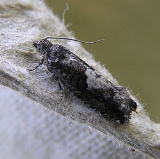
Epinotia immundana
Encyclopedia
Epinotia immundana is a moth
of the family Tortricidae
.
The wingspan
is 12–14 mm. In the British Isles
and adjoining areas of continental Europe, the moth flies from April to June and again, in the south, in August and September.
The larvae mainly feed on Alnus glutinosa, Birch
en Rose
.
Moth
A moth is an insect closely related to the butterfly, both being of the order Lepidoptera. Moths form the majority of this order; there are thought to be 150,000 to 250,000 different species of moth , with thousands of species yet to be described...
of the family Tortricidae
Tortricidae
Tortricidae is a family of moths, commonly known as tortrix moths, in the order Lepidoptera. Tortricidae is a large family with over 9,400 species described, and is the sole member of the superfamily Tortricoidea. Many of these are economically important pests. Olethreutidae is a junior synonym...
.
The wingspan
Wingspan
The wingspan of an airplane or a bird, is the distance from one wingtip to the other wingtip. For example, the Boeing 777 has a wingspan of about ; and a Wandering Albatross caught in 1965 had a wingspan of , the official record for a living bird.The term wingspan, more technically extent, is...
is 12–14 mm. In the British Isles
British Isles
The British Isles are a group of islands off the northwest coast of continental Europe that include the islands of Great Britain and Ireland and over six thousand smaller isles. There are two sovereign states located on the islands: the United Kingdom of Great Britain and Northern Ireland and...
and adjoining areas of continental Europe, the moth flies from April to June and again, in the south, in August and September.
The larvae mainly feed on Alnus glutinosa, Birch
Birch
Birch is a tree or shrub of the genus Betula , in the family Betulaceae, closely related to the beech/oak family, Fagaceae. The Betula genus contains 30–60 known taxa...
en Rose
Rose
A rose is a woody perennial of the genus Rosa, within the family Rosaceae. There are over 100 species. They form a group of erect shrubs, and climbing or trailing plants, with stems that are often armed with sharp prickles. Flowers are large and showy, in colours ranging from white through yellows...
.

